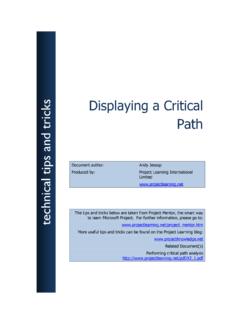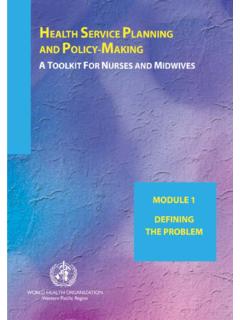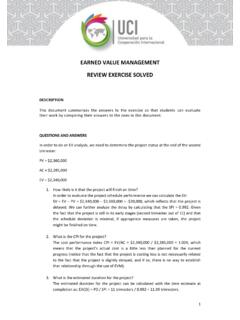Transcription of Performing critical path analysis technical tips and …
1 Performing critical path analysis Document author: Andy Jessop Produced by: Project Learning International Limited The tips and tricks below are taken from Project Mentor, the smart way to learn Microsoft Project. For further information, please go to: More useful tips and tricks can be found on the Project Learning blog: Related document(s): Displaying a critical path technical tips and tricks Project Learning International Limited PO Box 41-143, Lower Hutt 5047, New Zealand Performing critical path analysis Introduction A basic understanding of how a project's schedule is calculated can provide a much clearer understanding of what should happen when. At the heart of Microsoft Project is an algorithm that uses critical path analysis (CPA) to calculate a project s schedule.
2 Most Microsoft Project users are either unaware of the CPA algorithm at all, or they are unsure as to how it performs its calculations. These tips and tricks follow the CPA process step-by-step and provide a clear insight into how project schedules are calculated by Microsoft Project. Background As the tasks within a project have links between them, they cannot all happen at the same time. A technique entitled critical path analysis (CPA) can be used to determine what can happen when. It calculates how quickly and how slowly the tasks can be performed, taking into account the sequence of tasks and the interrelationships between them. Project reports such as Gantt charts are created as a result of critical path analysis .
3 Performing critical path analysisWhat critical path analysis calculatesCritical path analysis (CPA) is a mathematical procedure that calculates a project's schedule. Taking each task in turn it firstly calculates how quickly the task can be accomplished these dates have been calculated, the determined. With this finish date known, CPA can then ceach task can be accomplished (information is known for each task, CPA will also calculate the that the task possesses. Take the network of tasks and list the task's name and duration: Consider that the following values need to be calculated: ES = Early Start EF = Early Finish LS = Late Start LF = Late Finish TS = Total Slack Project Learning International Limited PO Box 41-143, Lower Hutt 5047, New Zealand critical path analysisWhat critical path analysis calculates critical path analysis (CPA) is a mathematical procedure that calculates a Taking each task in turn it firstly calculates how quickly the task can be accomplished - its early start and early finish dates have been calculated, the project finish date can also be With this finish date known, CPA can then calculate how slowly each task can be accomplished (late start and late finish dates).)
4 Once all this ion is known for each task, CPA will also calculate the slack Take the network of tasks and list the task's name and duration:Consider that the following values need to be calculated: Performing critical path analysis critical path analysis (CPA) is a mathematical procedure that calculates a Taking each task in turn it firstly calculates how quickly dates. Once all can also be alculate how slowly Once all this k (or float) Take the network of tasks and list the task's name and duration: Project Learning International Limited PO Box 41-143, Lower Hutt 5047, New Zealand Performing critical path analysis Calculating early dates for tasks Early start and early finish dates for tasks are calculated by a process known as a forward pass.
5 This proceeds through the project's network from the earliest occurring tasks (positioned to the left side of the diagram) to the latest occurring tasks (positioned to the right side of the diagram): a. Enter an ES value of 0 for any task that has no predecessor (as it can commence straight away). b. For each of the tasks with ES=0 values, their EF value will be calculated from the ES value PLUS the task's duration (for example; 'Design Structure' will have ES=0 and EF=5 (day number 5 of the project)). c. As 'Write body text' and 'Create exercises' have a common predecessor, the ES value for BOTH of them will be the same as the EF value for their common predecessor; day 5. d. The EF for 'Write body text' is calculated by ADDING the duration value (in this case 15 days) to the tasks ES value (day 5), thus finishing on day 20.
6 E. The EF for 'Create exercises' is calculated as operation four, with EF = ES+Duration (5+10 = day 15). f. 'Set page layouts' can commence as soon as its predecessor is complete; day 20. g. 'Test exercises' can commence once its predecessor is complete; day 15. h. EF values for 'Set page layouts' & 'Test exercises' can be calculated as EF = ES+Duration (days 25 and 20 respectively). i. As 'Create contents and index' has multiple predecessors, it can only commence when ALL of them are complete. Its ES value is therefore day 25 (the EF of its LATEST predecessor). j. The EF for 'Create contents and index' is simply ES+Duration - day 30. The project finish date is therefore day 30. Project Learning International Limited PO Box 41-143, Lower Hutt 5047, New Zealand Performing critical path analysis The calculated diagram would look like this: Hints Don't enter an ES value for a task until the EF values for ALL of its predecessors have been calculated.
7 Project Learning International Limited PO Box 41-143, Lower Hutt 5047, New Zealand Performing critical path analysis Calculating late dates for tasks Working through the network diagram from right to left, the backward pass calculates late start and late finish dates for each task: a. For all tasks without successors (in this case 'Create contents and index') the LF date will be the same as the EF date; day 30. b. The LS for 'Create contents and index' is calculated by SUBTRACTING the task's duration from its EF value (LS = LF-Duration); that is 30-5 = day 25. c. The LF values for ALL the immediate predecessors of 'Create contents and index' will be day 25 (the same as the 'Create contents and index' LS value).
8 D. 'Set page layout' will have a LS of day 20 (LF-Duration); 25-5 e. 'Test exercises' will also have a LS of day 20 (LF-Duration); 25-5 f. The LF of 'Write body text' is equivalent to the LS of its immediate successor ('Set page layouts', day 20). g. The LF of 'Create exercises' is equivalent to the LS of its immediate successor ('Test exercises', day 20). h. The LS for 'Write body text' and 'Create exercises' is calculated as LS = LF-Duration (days 5 and 10 respectively). i. As 'Design structure' must be complete before any of its successors can commence, its LF value will be equivalent to the EARLIEST LS value for its successors, in this case day 5. j. LS for 'Design structure' is simply its LF-Duration; day 0. Project Learning International Limited PO Box 41-143, Lower Hutt 5047, New Zealand Performing critical path analysis The calculated diagram would look like this: Hints Don't enter an LF value for a task until the LS values for ALL of its successors have been calculated.
9 Project Learning International Limited PO Box 41-143, Lower Hutt 5047, New Zealand Performing critical path analysis Finding tasks with spare time As the backward pass has determined how slowly work can be accomplished, there is often a difference between late and early values. Tasks possessing a difference between early and late dates are said to possess slack (or float). These tasks are known as non- critical tasks. To calculate slack values for each task, use the formula: TS = LF-ES-Duration The calculated diagram would look like this: Hints Exercise caution in telling people in your workgroup about slack as they may be tempted to use it without you knowing. Project Learning International Limited PO Box 41-143, Lower Hutt 5047, New Zealand Performing critical path analysis Highlighting critical tasks Some tasks possess no slack.
10 They are known as critical tasks. Any delay to them (or the path that they are on) will in turn delay the project s end date. critical tasks in a sequence are referred to as the critical path . Conventions usually state that critical paths are usually highlighted in red, and non- critical paths are shown in blue: Hints Tasks that are non- critical may still require careful management.









